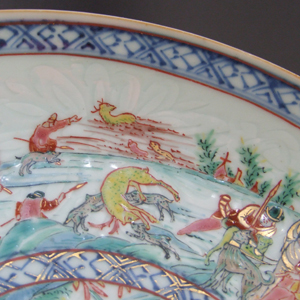
YONGZHENG or QIANLONG c.1730 – 1745 Dutch Decorated Chinese Export Porcelain
A Rare Dutch Decorated Carved Blue and White Chinese Export Porcelain Saucer Shaped Dish. The Porcelain and the Decoration c.1730-1745. The Highly Unusual Decoration Which Appears to be Reserved for Chinese Dishes of this Size with Carved Decoration Under the Glaze and Blue and White Diaper Borders is of Hunting Scenes.
SOLD
- Condition
- Perfect.
- Size
- Diameter : 22 cm (8 3/4 inches)
- Provenance
- N/A
- Stock number
- 23681
Information
The design is taken from a set of nine prints by Antonio Tempesta (1555-1630) that were published through the publisher C.J. Visscher in Amsterdam in 1631 under the title Animalium Quadrupedum Venatus in Usum Pictorum.
References :
For a pair of dishes of this design and the same shape with same Chinese decoration see : The Watney Collection of Chinese Porcelain Decorated in Holland and England, Bonham`s London, 7th November 2003, page 27, lot 39.
Published :
European Decoration on Oriental Porcelain 1700 - 1830 (Helen Espir, Jorge Welsh Books, 2005) page184, plate 37.
Provenance :
A pair were purchased from Oriental Art Europa, J. Bennett, Portobello Road, 24th May 1997.
The Helen Espir Collection of European Decorated Chinese Export Porcelain :
"a member of the Oriental Ceramic Society and collector, with her husband. Having made a typical collection of Song and provincial Ming blue and white, they decided to concentrate on what used to be called `clobbered` porcelain. She is the author of the standard work on the subject, European Decoration on Oriental Porcelain,2005, the first to examine the work of European decorators on Chinese porcelain throughout the eighteenth and nineteenth centuries, focusing on enamellers in Holland, Germany and England. She has learned Chinese." From Provenance ; Collectors, Dealers & Scholars : Chinese Ceramics in Britain & America (Roy Davids, Dominic Jellinek, Privately Printed, 2011. ISBN 978-0-9570148-0-0).
Antonio Tempesta (1555 – 5 August 1630) was an Italian painter and engraver, a point of connection between Baroque Rome and the culture of Antwerp.[1] He was born and trained in Florence and painted in a variety of styles, influenced to some degree by "Contra-Maniera" or Counter-Mannerism. He enrolled in the Florentine Accademia delle Arti del Disegno in 1576, and was a pupil of Santi di Tito, then of the Flemish painter Joannes Stradanus. He is now best known as a printmaker in etching and engraving. Among his followers was Marzio di Colantonio.
He was part of the large set of artists working under Giorgio Vasari on the interior decoration of the Palazzo Vecchio.
His favorite subjects were battles, cavalcades, and processions. He relocated to Rome, where he associated with artists from the Netherlands, which may have led to his facility with landscape painting.








